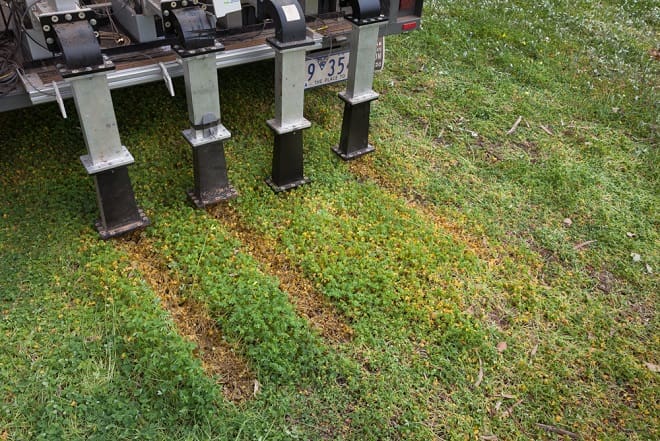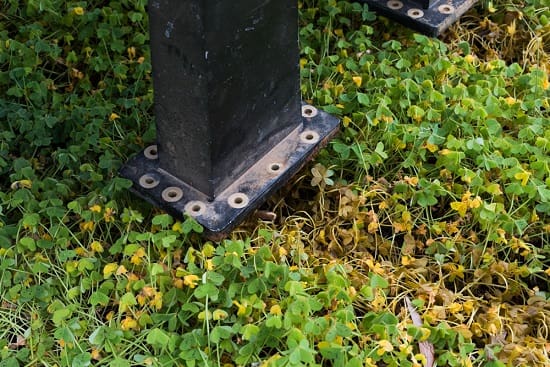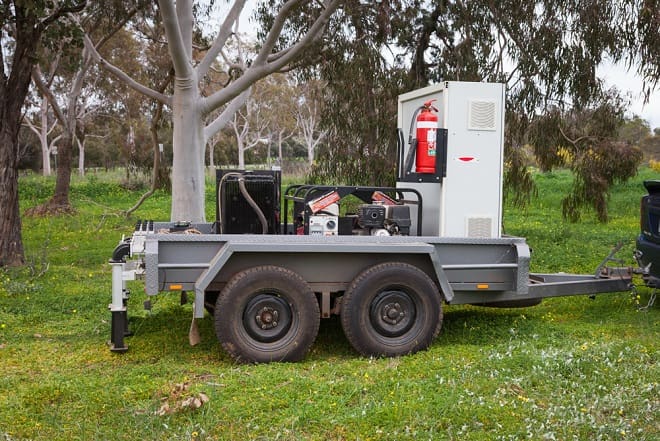
The University of Melbourne, in partnership with agtech company Growave, has developed prototype machines which harness the power of microwaves to control weeds and diseases. (Photo: Uni of Melbourne)
HI-TECH machinery that uses microwaves to scorch problem weed plants and destroy weed seeds is finding a niche in the horticulture industry and has potential for wider application in the broadacre cropping world.
The University of Melbourne, in partnership with agtech company Growave, has developed prototype machines which harness the power of microwaves to control weeds and diseases in intensive horticulture situations.
The semi-commercial prototypes have been successfully used in a number of on-farm experiments and demonstrations and the hope is that sometime soon those technologies will be adopted in commercial farming environments.
Researchers at the university have been working on the technology since 2007 when Faculty of Veterinary and Agricultural Sciences Associate Professor Graham Brodie pulled apart a microwave oven and reconfigured it to project microwave energy into the ground through an antennae.
The aim at the time was to explore the potential for microwaves to kill weed seeds in the soil.
“We found that it could. Not only could it kill weed seeds in the top couple of centimetres of soil but the effect was longer lasting,” Associate Professor Brodie said.
“We then did experiments where we treated patches on bare ground which lasted for more than 200 days without any encroachment (of plant growth).”
That prompted researchers to conduct further experiments to determine the response of the soil that was being heated.
“We started with wheat into microwave-treated soil and compared that to untreated soil,” he said.
“I remember telling my student who was helping me that if we didn’t cause damage to these plants when we planted them into the treated soil I’d be very happy. It exceeded expectations. We discovered that planting crop plants into treated soil after it had cooled resulted in an amazing increase in the growth and yield of the plants.”
Steam explosions
Associate Professor Brodie said while the initial focus had been on neutralising weed seeds, the research expanded into assessing the potential for microwaves to eliminate weed plants.
“Because it takes a lot of energy to heat the soil to the necessary temperatures to kill the seeds, we then started to explore whether we could actually kill the weeds which had already grown above the ground. That was the next phase of the experimental work,” he said.
“I developed new applicators which confined the microwave energy to a very shallow depth, effectively really to just treat the plants that were above the ground. We discovered we could kill already-emerged weeds very quickly.
“The microwaves effectively create little steam explosions inside the plants and rapidly boil the water that is already in the plants. That kills the plant and creates a bare patch within a day or two of the treatment.”

The microwaves kill the weeds by creating little steam explosions inside the plants. (Photo: Uni of Melbourne)
Herbicide-resistant weed control
Associate Professor Brodie said he saw potential for microwave weed elimination to extend its role into specific situations in broadacre agriculture.
“It will be a while yet before we have something that can race through a paddock and treat a wide swathe. But with the advent of herbicide resistance which often starts in a patchy way, I think there are prospects for resistant patches to be treated and completely eliminated. That is one potential application. The other is on headlands,” he said.
“And it could have application in managing the seed production of cropping so you get a much cleaner seed sample without weed seeds amongst it.”
Associate Professor Brodie said the microwave system used to kill weeds and pathogens worked in exactly the same way as a microwave oven.
“It generates a type of light that is readily absorbed by a number of materials, but in particular water. The absorption of that energy from the light creates vibrations in the molecules which heat,’ he said.
“In the case of killing weed plants, that heat is quickly generated inside the plants. It is not on the surface like you have with flaming or steaming. It creates steam explosions inside the plant cells and that ruptures the cells, so the plant dies. With seeds, it cooks the embryo so it can’t germinate.”
Path to commercialisation
In recent developments on the way to adoption, Growave has launched a capital raise, aiming to close $5 million.
It has also captured the interest of a French champagne company, as well as strawberry growers in California looking to utilise the microwave technology to rid farms of fungi and pathogens in soil.
In 2019 the company raised nearly $1 million for the commercialisation of the product.
Recent trials by Growave have shown microwave technology can effectively control weed and disease in strawberry crops, resulting in increased crop yield and eliminating the need for herbicides.
The recent field trials on strawberry farms in Victoria concluded the prototype microwave technology destroyed 95 per cent of fungal disease.
Growave head of product and robotic engineer Liam Hescock said farmers were highly engaged as the technology was solving problems where no viable alternative existed.
“Farmers use fumigants to treat pathogens in the dirt after harvesting a crop. Pathogens can lay dormant for 12 months in dead crops, but herbicide doesn’t kill charcoal rot,” Mr Hescock said.
“Charcoal rot is a significant problem for the strawberry industry, with 90 per cent of Victorian strawberry crops affected last year.
“One of the biggest issues for farmers is weeds like nutgrass. It’s a bulbed weed, and the more you turn the soil trying to pull it out, the further it spreads, so if we can take out the nutgrass using Growave’s microwave technology, it will save farmers thousands of dollars a year.
“Our patented microwave technology allows for efficiently targeting heat that destroys select weeds, buried seeds, and pathogens. It penetrates the target and destroys the cell structure from the inside permanently.”
Today, the machine is towed behind a tractor, going row by row. The team ultimately envisages the technology will be configured on an autonomous platform.

The microwave machine is currently transported on a towed trailer, but ultimately it will will be configured on an autonomous platform.
Grain Central: Get our free cropping news straight to your inbox – Click here

HAVE YOUR SAY